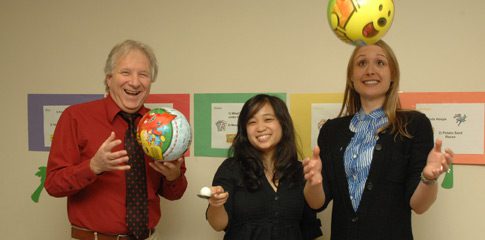Faculty Info
Name: Jeffrey M. Halperin
Title: Distinguished Professor
Department: Psychology; also on the Neuropsychology faculty at the CUNY Graduate Center
Degree(s): B.A. City College of New York in 1973; Ph.D. CUNY Graduate Center in 1979.
Contact Information:
Phone: (718) 997-3254
Office: Science Building, Room A350
Email: jeffrey.halperin@qc.cuny.edu
“Environmental influences really can affect brain development.”
– Jeffrey M. Halperin
Past Profiles

Queens College Distinguished Professor of Psychology Jeffrey Halperin, far left, and colleagues from his AD/HD treatment study program, Carol Yoon, center, and Jocelyn Curchack, demonstrate one of the games they use to help children learn how to better manage their disruptive behavior.
Is Ritalin the right remedy for hyperactive children? Jeffrey M. Halperin, who has published more than 100 scientific papers, doesn’t dispute the short-term effectiveness of such medications. His approach, however, is to develop therapies to re-train the brain. By teaching preschoolers cognitively challenging games that are fun to play, his team aims to help them lay down new or more efficient drug-free neural pathways to manage their disruptive behavior.
In the past five years Halperin has garnered more than $4 million in NIH grants to study attention-deficit/hyperactivity disorder (ADHD) and related disruptive, antisocial, and substance use disorders. Because ADHD is not a single disorder, notes Halperin, “We want to understand the genetic, neurological, and environmental factors that come together and influence growth and development.”
ADHD disrupts the lives of an estimated 5-to-10 percent of school-age children. For most, “it’s there by birth,” Halperin notes. “ADHD is associated with delayed brain development. Environmental influences really can affect brain development.” He believes that such influences are most potent when occurring in real-world natural settings. That’s why his interventions take place in a social setting, not via computers.
The QC Preschool Project, also headed by Halperin, distinguishes inattentive/hyperactive children who develop ADHD from those who do not. Halperin’s team originally recruited 216 families with 3-to-4-year-olds, two-thirds of whom seemed to be at risk for later behavioral/cognitive difficulties; they are now 8-to-10.
“We’re really beginning to develop some clues and ideas about the trajectory of ADHD,” Halperin says. “For many children, it seems as if the early hyperactivity is a developmental blip. They seem to outgrow it by 6 or 7. It doesn’t mean a life sentence, although for some difficulties do persist.”
As part of their TEAMS (Training Executive, Attention and Motor Skills) treatment study, Halperin’s colleagues show parents how to create enriched environments and to engage their children in playful activities such as “Puppet Says” and “Freeze Dancing” (being statues when the music stops). These potentially brain-building games may involve words, memory, motor skills, focusing, impulse control, or remembering and carrying out a sequence of tasks while helping mom cook. “We want these games and activities to become part of their lives,” Halperin explains. All can be “scaffolded,” that is, gradually made more challenging.
So far their preliminary data are encouraging. Three months after TEAMS treatment is completed, “the children are doing a lot better,” Halperin observes. Even before conducting randomized controlled trials, what he finds “particularly attractive at this point is the promise of non-pharmacological treatments” to calm things down for the children—and their grateful parents and teachers.
Books he recommends: For parents: Russell A. Barkley’s Taking Charge of ADHD: The Complete Authoritative Guide for Parents. For himself: “I’m always reading a novel,” especially spy thrillers and detective stories.
Musical interests: “I’m fairly eclectic”—1960s folk, rock, and classical
Surprising fact: Worked early on as a cab driver, postal worker, and census taker

